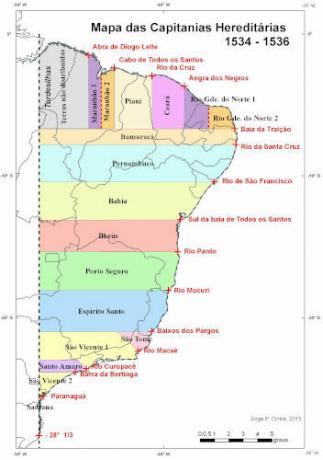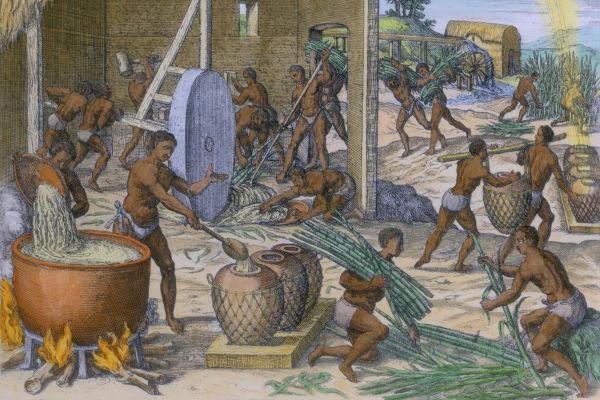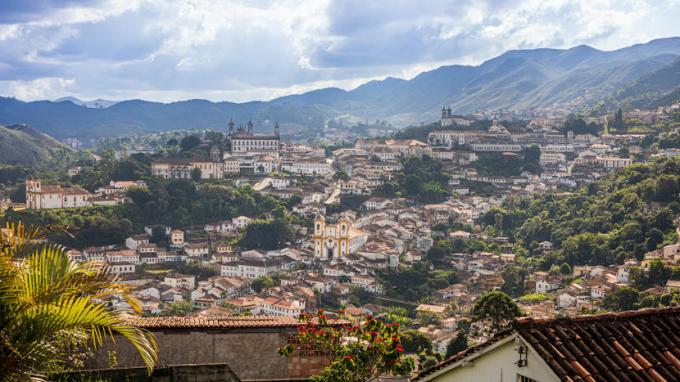THE colonization of Brazil began in 1500 with the arrival of the Portuguese in our territory, although effective actions of colonization only developed in the 1530s, with the establishment of the captaincies. hereditary. The Portuguese colonization took place until the year 1822, when we conquered our independence (Some point out that 1815 was the final year).
The colonization of Brazil had three major economic cycles, that of pau-brasil, sugar and gold. The majority of labor was that of indigenous and African enslaved people, the former being obtained by scouts and the seconds were brought by the slave trade. Colonization was also marked by numerous revolts.
Accessalso: French colonization in the Americas - context, regions and economy
arrival of the portuguese

Chronologically, it is considered that the colonization of Brazil began in 1500, when the Pedro Álvares Cabral's expedition he saw Monte Cabral. The expedition arrived in Brazil on the day
April 22, 1500 and it was a consequence of great navigations, the ocean explorations carried out by Portugal throughout the 15th century.Cabral's expedition had pairmission when he left Lisbon in March: check the Portuguese possibilities in America and sell in the Indies. In Brazilian lands, the Portuguese remained until May 2, when they left for the Indies. The greatest details of this event were reported by the expedition clerk, Pero Vaz de Caminha. To learn more about this first moment in the history of Brazilian colonization, read: Discovery of Brazil.
Pre-Colonial Period
From 1500 until around 1535, Brazil occupied a secondary position to the Portuguese Crown because, at that time, Portugal's priority was to maintain the spice trade. This moment is known as the Pre-Colonial Period, since the Portuguese had not established consistent colonization actions in Brazil.
The Portuguese presence in this period consisted of explore brazilwood, native tree that had value to the Portuguese because of a dye extracted from its wood. The main workforce in this type of exploration were the indians, especially when the tree became scarce on the coast.
To explore pau-brasil, the Portuguese mobilized the Indians through the barter, that is, by exchange. The Indians located, extracted and carried the logs to factories built by the Portuguese on the Brazilian coast, and, in return, they received various objects, such as axes. From the 1530s onwards, this activity lost steam, as did the spice trade, and the Portuguese decided to establish more effective colonization measures.
Hereditary captaincies

Hereditary captaincies were the first major measure taken by the Portuguese to systematize the colonization of Portuguese America. However, this measure basically worked as an “outsourcing” of obligations, in which third parties invested with their own funds in the development of the captaincy.
The captaincies were created in 1534 by order of the king d. John III. The Portuguese decided to divide the Brazilian territory into 15 land strips, each being the responsibility of the donor captain, the ultimate authority of these captaincies. The rights and duties of grantees were contained in documents called Donation Letter and LetterCharter.
Grantees had the obligation to guarantee the development of their captaincies, in addition to defending them from indigenous and foreigners. The French were the greatest threat to the Portuguese because it was common for their lands to be invaded by them in the 16th century. The French even had good relations with natives who were enemies of the Portuguese.
Here in Brazil, grantees received a allotment, a plot of land to settle down. After more than a decade of this system, the Portuguese identified that it had not prospered as expected, and only two captaincies had significant results: São Vicente and Pernambuco. Lack of resources and administrative inexperience were two factors that contributed to their failure. If you want to go deeper into the first administrative system in colonial Brazil, read: Hereditary captaincies.
general government
From 1548 onwards, Portugal decided to centralize the administration of the colony, and for this it was created, by d. John III, the general government. Some captaincies continued to exist in Brazil, but others were taken over by the Crown (such as the captaincy of Baía de Todos os Santos). Still, grantees now had to answer to a central authority, appointed by Portugal.
This new authority became known as general governor, and the first governor general of Brazil was ThomasinSousa. The governor-general also had a group of bureaucrats who helped him in the administration of the colony. The first positions created were that of chief ombudsman (justice), main provider (finance) and Captain General (safety).
Tomé de Sousa arrived in Brazil in 1549, and, during his administration, the construction of the first capital of Brazil began: savior. With Tome de Sousa came the first Jesuits to Brazil, and its mission was pacify and catechize indigenous populations. The Jesuits remained in Brazil for over two centuries, being expelled from here in 1759 by the marquis of pombal. If you want to know more about the topic of this topic, read: general government.
colonial economy

Traditionally, historians have schematized the colonial economy in three major cycles, which were: Brazilwood cycle, sugar cycle and gold cycle. An important observation is that to say that colonization was marked by these three great cycles does not mean that there was no other economic activity in Brazil.
These three cycles corresponded to the main economic activities of colonization, however, Portuguese America had a great variety of economic activities. Livestock and agriculture were practiced, mainly for subsistence, and there were also other items produced for export, such as tobacco.
There was also a small trade, except for the slave trade, which was considerably prosperous. Despite this diversification, there was no kind of manufacture in Brazil, as it was not allowed by Portugal.
Let's look at some observations about these three great cycles:
Brazil wood: as we have seen, its exploration aimed at dye extracted from wood. Its extraction was carried out by the Indians, and payment was made through barter, that is, through exchange: Indian labor was paid by the Portuguese with objects and tools.
Sugar: Sugar was the most important product produced in Brazil during part of the 16th century and throughout the 17th. As far as is known, the intention of the Portuguese to install sugar mills in Brazil to produce sugar dates back to 1516, but only in 1535 were the first gadgets in Brazil (in the captaincy of Pernambuco).
Gold: third major economic cycle during colonization. Expressive amounts of gold were found in Minas Gerais, in 1695, and the first diamond stones were found in 1730. Gold attracted thousands of people to Brazil and turned Minas Gerais into the great center of Portuguese America. There were also significant amounts of gold in Goiás and Mato Grosso. The Portuguese regulated the extraction of gold through taxes, such as the fifth.
Read more: Urban space in colonial Brazil
Slavery

The colonization of Brazil was an undertaking in which Portugal exploited the resources existing in the Brazilian territory, in addition to human lives. The main labor used by the Portuguese during colonization was that of the Indigenous and African enslaved. It is estimated that slavery was implemented in Brazil in the 1530s.
This happened, therefore, when the Portuguese decided for the more systematic occupation and exploitation of Portuguese America. The first group enslaved in Brazil were the indigenous, mainly because they were available in large quantities so that the Portuguese could enslave them.
Slavery was a violent institution that placed human beings in cruel conditions. Millions of Indians and Africans died for all the violence they suffered from the Portuguese during the three centuries of colonization. The enslavement of indigenous people was prohibited by the Marquis of Pombal, in 1757, and the enslavement of Africans and their descendants only ended in 1888, more than 66 years after our independence was won.
The Indians were the main slave labor until the mid-17th century, when they began to be outnumbered by enslaved Africans. A series of issues contributed to the replacement of indigenous labor by African ones. Historians argue that the reduction of the indigenous population and biological issues contributed to Africans becoming more important.
Thus, the high demand for enslaved people, the reduction of the indigenous population and the profitability of the slave trade contributed to the Africans becoming the main enslaved group in Brazil. The enslavement of Africans carried out by the Portuguese did not start in Brazil, as, in the 15th century, the Portuguese were already buying Africans to be enslaved in Lisbon.
The slave trade was one of the most lucrative (and cruel) activities of colonization and was responsible for the arrival of almost five million Africans to Brazil. The slave trade brought enslaved Africans to Brazil for three centuries. prohibited only in 1850. In the indigenous case, however, those most responsible for capturing them to resell them as slaves were the scouts.
The pioneers were sertanistas who penetrated into the interior of Portuguese America, exploring the lands, mainly looking for wealth and indigenous. Indigenous people were violently captured and resold, especially in São Paulo, for their great demand.
Girl scouts were also hired to capture fleeing African enslaved, they organized expeditions that attacked quilombos, settlements formed by runaway slaves. The best known case in our history was the Quilombo dos Palmares. Finally, the pioneers were also responsible for locating gold in different parts of Brazil. If you want to know more about this inhuman institution, read: slavery in Brazil.
other events
The colonial period was also marked by a series of revolts that took place due to multiple factors and which, in general, manifested the colonists' dissatisfaction with the Crown. Over three centuries of history, we can cite the following revolts:
Beckman Revolt
War of Emboabas
Peddler War
Vila Rica Sedition
Mining Inconfidence
Bahia Conjuration
Guaranitic Wars
Also, the territory of the Portuguese colony was invaded by foreigners, and two cases are symbolic: the French and the Dutch. You french tried to establish a colony in the Portuguese territories in two moments, known as France Antarctica (1555-58) and France Equinocial (1594).
O Dutch case it was more complex and had to do with the Iberian Union and the rivalry between the Dutch and the Spaniards. The Dutch attacked Salvador in 1595 and conquered the city in 1624, being expelled the following year. In 1630, they attacked Olinda and Recife, taking over Pernambuco and remaining there until 1654, when they were expelled.
read more: After d. João VI returned to Portugal, d. Pedro assumed the regency of Brazil
end of the colonial period
From an official point of view, the colonization of Brazil ended in 1815, when king d. João VI elevated Brazil to kingdom condition. With this, Brazil ceased to be a colony and became an integral part of the kingdom of Portugal. Many historians extend the colonization to the date of 1822, since, even though it was no longer a colony, Brazil was still linked to Portugal.
Furthermore, even apart, there were interests in Portugal that defended the idea that Brazil would be “recolonized”. This situation did not last long because the relationship between the Portuguese and Brazilians and the differences in interests led to the process of independence in Brazil, in September 7, 1822, under the leadership of d. Peter I.
Image credits
[1] nephthali and Shutterstock
[2] Jorge Pimentel Cintra (2013)
[3] Luis War and Shutterstock

